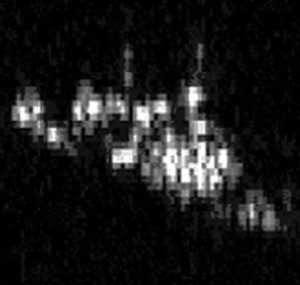Test your analytic skills
Can you tell what you’re looking at in this long-range radar image? See the answer below.
This is a frigate seen in an inverse synthetic aperture radar image. To generate ISAR images like these, the radars on maritime surveillance planes stop scanning to focus on specific objects. Doppler shifts in the radar reflections are collected as the objects move across the sea. Software turns those readings into images and automatically classifies the objects based on their lengths and features. “ISAR allows you to tell whether it’s a combatant ship or fishing vessel or a cargo ship, and you can do it at significant ranges – 50, 60, 70 miles,” says Raytheon’s Brad Hopper, senior business development manager for intelligence, surveillance and reconnaissance.
Raytheon recently demonstrated automated ISAR for Australian customs officials as part of a software upgrade the company hopes to convince them to undertake. Today, Raytheon SeaVue radars scan Australian coastal waters from Dash 8 turboprops flown by Cobham under an initiative called Project Sentinel. In the demo, Raytheon upgraded a Dash 8 radar to the SeaVue XMC software configuration, short for Expanded Mission Capability. SeaVue XMC automatically detects and tracks thousands of targets for operators, instead of today's 100 or 200, and can automatically focus in on the most suspicious of them using the ISAR mode, Hopper says.



